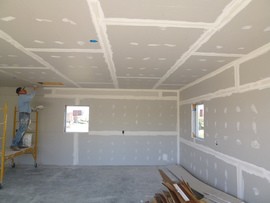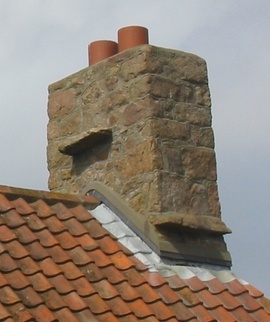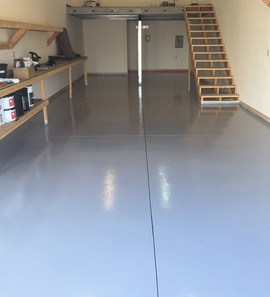How Much Does It Cost Recover from Storm Damage?
Storms can wreak havoc on homes, causing different types of damage, from damaged roof shingles to water damage to cracked siding. Whether your home has been through a tornado, severe thunderstorm, lightning strike, or hail storm, you have likely incurred some damage that will need to be replaced. In some situations, the damage can be minor. In others, it can be so severe that you aren’t able to inhabit your home until it’s repaired. Leave the house if it isn’t safe inside, and you can safely move outdoors. Once all your family members are safe, the next step is to call a storm recovery professional to assess the damage and begin repairs.
The overall costs you will pay for storm damage repair will depend on where the damage occurred, the extent of the damage, and what type of damage your home has suffered. The average costs for home repairs after a storm run between $3,000 and $7,000, with most homeowners paying $5,200 for repairs to their roof shingles and minor siding replacement. Prices can be as low as $2,500 for damage from and removing a fallen tree to as high as $30,000 if a roof has to be replaced after significant wind or hail damage.
Storm Damage Recovery Cost
| Cost to Repair Hail Damage | |
|---|---|
| National average cost | $5,200 |
| Average range | $3,000-$7,000 |
| Low-end | $2,500 |
| High-end | $30,000 |
Storm Damage Recovery Cost by Project Range
Storm Damage Recovery Cost by Type of Damage
Storms can cause all types of damage to your home, and it is the type of damage that your home experiences that will determine the cost to rectify the damage. In some cases, a storm may cause more than one type of damage leading to multiple types of recovery to get your house fully repaired. On average, homeowners pay anywhere from $200 to $12,000 for repairs depending on the damage type. Below you will see the average repair cost you can expect based on which type of damage occurs from the storm.

| Type of Storm Damage | Average Repair Costs |
|---|---|
| Ice and Snow | $200 - $1,200 |
| Smoke | $250 - $1,200 |
| Mold | $1,500 - $3,500 |
| Tree | $1,500 - $5,000 |
| Water | $2,000 - $5,000 |
| Thunderstorm | $2,800 - $5,500 |
| Hail | $3,000 - $12,000 |
| Tornado | $4,600 - $17,000 |
Freeze Damage House
One of the biggest issues that winter storms can lead to is power outages which can be a problem when the temperatures outside are freezing. You can expect to pay between $200 and $1,200 if you have damage to your home from a freeze. One of the most common problems from freezing temperatures in the home is burst pipes, resulting in water damage in various parts of your home. You also may have damage to the shingles 1 on your roof if there is ice build up and your home is not warm enough to melt it.
Smoke Damage in House
If you have smoke damage in your home due to a storm, you can expect to pay between $250 and $1,200 for repairs. Smoke damage can occur when lightning strikes your home, leading to a fire. You could suffer smoke damage if your home experiences a fire from downed power lines or electrical surges during high winds.
Mold Damage in House
You can expect to pay $1,500-$3,500 for repairs if mold damage is found in your home. Water from heavy rains can lead to water making its way into your home, whether through leaks or floods. If water is not properly remediated immediately or if some water is missed in the process, mold can form. This can lead to possible health hazards if not rectified.
Tree Damage to House
You can pay anywhere from $1,500 to $5,000 in repairs if a tree falls on your home during a storm. Heavy winds and lightning can lead to damage to the roof, windows, or siding of your home. The cost for repairs will include repairs or replacement to the area where the tree struck, along with the removal of the tree itself. If the tree is still rooted to the ground, you will need to add the cost for root removal and dirt fill-in, raising the costs.
Water Damage Restoration Cost
Water damage is a common problem caused by storms and can cost anywhere from $2,000 to $5,000 in repairs. Heavy rains can worsen roof leaks and flood damage, requiring repair and replacement of drywall 2, carpet, hardwood floors, and padding 3. Water damage will need to be properly remediated to reduce the risk of mold and warping.
Thunderstorm Damage
Damage from thunderstorms usually is caused by high winds, heavy rains, and lightning. Repairs for the damage can cost homeowners an average of $2,800 to $5,500. The most common type of repairs associated with thunderstorm damage includes water remediation, roof and siding repair, and even tree removal. The amount of your repairs due to a thunderstorm will depend on the event that caused the damage and what area needs to be repaired.
Cost to Repair Hail Damage
Hail damage from a storm is one of the most costly repairs ranging from $3,000 to $12,000 depending on the hail's size and where the damage has occurred. Most often, hail damage will lead to roof or siding damage and usually requires sections to be replaced. In some cases, hail damage can occur on windows and skylights, which will likely lead to the need for a full replacement.
Tornado Damage Cost
Damage from a tornado can be costly to repair, running an average of $4,600 to $17,000. Damage to your home from a tornado is often the result of high winds or being struck by debris such as branches and trees. You are likely to have damage to your roof and siding and require extensive cleanup from the flying debris. The high winds from tornadoes can cause electrical wiring problems, leading to surges that require an electrician to repair.
Storm Damage Recovery Cost by Location
Recovery from storm damage can run anywhere between $125 and $8,000, depending on the damage's location. The location plays a vital role in the recovery cost as different locations will require different materials and labor to repair properly. Below you will see some of the most common locations where storm damage occurs and the average costs to fix each.

| Location of Damage | Average Repair Cost |
|---|---|
| Gutters | $175 - $550 |
| Window | $175 - $700 |
| Siding | $300 - $2,000 |
| Tree | $400 - $900 |
| Basement | $1,000 - $2,000 |
| Car | $1,000 - $3,500 |
| Roof | $1,000 - $8,000 |
| Foundation | $1,800 - $6,500 |
Hail Damage to Gutters
Gutters are at high risk for damage during a storm due to their location and function during storms. You can expect to pay anywhere between $175 and $550 to repair sections of gutters damaged by storms. In most cases, repairs will involve replacing sections of the gutters that have been damaged or broken off due to high winds, ice, or other storm concerns.
Broken Window Repair Cost
Broken windows from storms will likely need to have a pane replaced or a full replacement. This will cost homeowners an average of $175 to $700. Windows can easily become cracked or broken from hail storms or extremely high winds. If you have high energy-efficient or customized windows, a replacement can run into the thousands.
Siding Storm Damage
Siding is one area of your home likely to sustain some type of damage in a major storm. Repairs to siding can range anywhere from $300 to $2,000, depending on the damage's extent and cause. Most siding damage is caused by high winds or hail. Repairs often include replacing or repainting damaged sections. Below you will see the average costs for siding repairs based on the type of damage.

| Type of Siding Damage | Average Repair Cost |
|---|---|
| Hail Damage | $300 - $1,000 |
| Wind Damage | $800 - $2,000 |
Hail Damage Siding Repair
Damage to your siding caused by hail will cost between $300 and $1,000 to repair. Hail damage often leads to dents or cracks in sections of the sidings. When this damage occurs, the dented or broken siding section will need to be removed and replaced with a new piece. In cases of small hail, siding can become scratched and simply need to be repainted.
Wind Damage to Siding Repair
You can expect to pay between $800 and $2,000 when repairing your siding after storm damage. High winds can bend and break pieces of siding, and in some cases, even strip pieces away. Repairs after this type of damage will normally consist of replacing damaged or missing siding sections. It is important to have your siding properly checked after a storm as small cracks and chips can quickly worsen if not repaired.
Fallen Tree Removal Cost
Lightning and high winds can lead to fallen branches and trees, which will often need to be removed from the area during storm cleanup. You can expect to pay between $400 and $900 for its removal. The costs will depend on the tree's location, size, and whether the roots will still need to be removed. Trees that are still rooted will require extra labor to properly remove all the roots. Trees that were dead before falling will take less time as there will not be any pruning required before the trunk is cut.
Flooded Basement Cleanup Cost
Heavy rains during storms often lead to flooding, and unfortunately, basements are prime targets for this kind of damage. Cleaning up a flooded basement can run between $1,000 and $2,000. Cleanup would involve removing all water and a mold inspection if the water was sitting for a long time. If mold is present, mold remediation will be necessary to complete cleanup.
Storm Damage to Car
Another likely piece of property that can suffer storm damage is your vehicle. When you have to repair storm damage on your car, you can expect to pay anywhere from $1,000 to $3,500. In most cases, the damage to your vehicle will be covered by insurance. Still, if you have an older vehicle with a lower value, significant storm damage may result in the insurance company totaling the vehicle. How much you will pay depends on the cost of parts that need to be replaced and how many areas of your vehicle suffered damage. Below you will see the two most common vehicle damage types and the average costs to repair each.

| Type of Car Damage | Average Repair Cost |
|---|---|
| Hail Damage | $1,000 - $2,000 |
| Wind Damage | $1,500 - $3,500 |
Hail Damage Car Repair Cost
Hail damage to your car will run between $1,000 and $2,000 to fix. Most hail damage leaves dents on the exterior pieces of your vehicle and broken windows or sunroofs. The size of the dents will depend on the size and velocity of the hail. In most cases, the panels on your vehicle that have been hit will have to be replaced.
Wind Damage to Car
Wind damage from tornadoes and other major storms can lead to repairs running between $1,500 and $3,500. Wind damage often includes major dents from flying debris and possible severe paint damage throughout the vehicle. Vehicle windows and panels may often need to be replaced. In some cases, the entire car will need to be repainted.
Storm Damage Roof Repairs
One of the most common repairs needed after a major storm is roof repairs, which can run anywhere between $400 and $8,000 depending on the extent of the damage and what type of damage the roof has sustained. Most often, roofs will be damaged due to hail, wind, rain, or ice. Below you will see the average cost for repairs of these common types of roof damage.

| Type of Roof Damage | Average Repair Cost |
|---|---|
| Roof Leaks | $400 - $1,000 |
| Ice Dams | $400 - $2,000 |
| Hail Damage | $700 - $4,000 |
| Wind Damage | $2,000 - $8,000 |
Cost to Repair Roof Leaks
Heavy rains that come with storms can lead to slight roof leaks becoming major problems. Repairing these roof leaks runs an average of $400 to $1,000. Roof leaks should never be left unaddressed even if the rainy season has passed. When you have a leaky roof, even lighter rains can cause water to get inside the home, leading to damaged insulation and mold.
Cost to Remove Ice Dam
Winter storms bring heavy snow and ice buildup, especially on your roof, and can even cause ice dams. Ice dams can cost between $400 and $2,000 to remove from your roof, with the cost depending on the ice's location and thickness. These dams are often caused by snow on the roof melting and then refreezing along the edge. If left unaddressed, they can easily lead to water damage in the home. When you have ice dams removed, your professional will know how to properly remove them without causing any damage to your roof.
Hail Damage Roof Repair Cost
Hail damage is one of the more costly roof repair types, running between $700 and $4,000. When a hail storm hits your home, it can damage the shingles 1 on your roof, ruining their integrity and making them more prone to leaks. In some cases, it can break the shingles completely. If not repaired, your home is more susceptible to more extensive damage. Repairing hail damage to the roof usually involves removing and replacing sections of your roof, which is why it can be so costly.
Wind Damage Roof Repair
High winds can cause the most significant damage to your roof, with repair costs running between $2,000 and $8,000. High winds can damage your roof in many ways. Strong winds can uplift your shingles and rip apart roofing materials. Winds can also push debris from storms onto the roof. Branches and trees can be pushed on the roof, causing damage as well.
Foundation Water Damage
Extensive and prolonged water sitting around your foundation can lead to damage that runs $1,800 to $6,500 to repair. Most commonly, water damage leads to foundation cracks, resulting in the shifting of your home if not addressed. Additionally, failing to address foundation issues on your home could result in problems trying to sell it in the future. The cost to repair the foundation depends on how extensive the damage and whether the water needs help being directed away from the foundation.
Labor Costs to Repair Storm Damage
Labor costs for repairing storm damage will run between $50 and $200 per person per hour. But the actual cost and number of people required will depend on what repairs are being done. Roof damage and water damage tend to run at a higher rate, as much as $75 per hour. Repairs often require two or more workers. Repairs to your home’s siding may bring a labor rate of $50 per hour on average, typically requiring two workers. The highest labor rates will be for foundation repair, which runs an average of $200 per hour and requires at least two workers onsite.
Typically, the repair process will start with an inspection by a professional contractor. They will go through the damage in your home, assessing both primary and secondary damage that has occurred, and provide you with a quote based on their recommended repair plan.
Once you have accepted an estimate, your contractor may begin making repairs. Depending on the extent of the repairs, it may be best for you to have another place to stay while they are made.
Storm Damage Roof Replacement Cost
Storm damage roof recovery costs are expensive. Severe damages can cost greatly. You may end up paying between $20,000 and $30,000 if you suffer a roof collapse or have sustained enough damage on your roof to warrant a full replacement. If you have significant damage to 50% or more of your shingles, have warped shingles, or the damage has resulted in several leaks throughout your home, the insurance company may recommend replacement over simple repairs. Additionally, if your roof's structure has been compromised, a replacement would be the better option.
Storm Damage Inspection
On average, you can expect a storm damage assessment to cost around $350. In most cases, the inspection will be completed by a professional contractor. Thorough inspections of the home will be needed to ensure that all damage is accounted for.
The inspector will then submit their quote to your insurance company. Your insurance company may just accept the quote or may also send out their own inspector. In some cases, if the prices from both quotes are close, either the insurance company or the contractor may match each other's estimates. Otherwise, you have to pay the difference.
Roof Inspection After Hail Storm
If your home has just been through a hail storm, you will want a professional contractor to come out to the home to assess the roof damage. It is critical to have a thorough inspection as some damage may not be apparent to the untrained eye, such as damaged flashing 4 or small cracks that can lead to leaks.
Storm Damage House Insurance
Most storm damage will be covered under a standard homeowner's insurance policy, though minor damage may not be worth claiming if you have a higher deductible. Suppose you suffer enough damage to file a claim. Your homeowner's insurance will likely cover the exterior and interior of your home as well as outbuildings up to the limits of your coverage.
You can expect them to cover broken windows, burst pipes, damaged roofs and siding, and water damage caused by roof leaks from heavy rain. Most homeowner's policies will not cover water damage resulting from flooding unless you have separate flood insurance.
Other types of damage may or may not be covered depending on the circumstances surrounding the damage. One example is falling trees. Most homeowner's policies will cover the cost of tree removal and damage caused as long as it was not considered a risk before the storm. That means if the tree was in poor condition, such as rotting, which made it likely to fall may cause your claim to be denied. Removing rotting trees is part of the basic maintenance expected of homeowners by their insurance companies. Failing to keep up on the maintenance can make the insurance company deem the damage the homeowner's fault.
It is important to note that each insurance company has its own way of calculating and covering damage. If the insurance inspector and contractor’s assessment of the damage differ, you will likely be covered only up to what the insurance company has determined the repairs should be. If you are unsure what type of damages are covered, contact your insurance company to get specifics on your policy information.

Enhancement and Improvement Costs
Backup Generator Installation
Installing a backup generator will run anywhere between $10,000 to $20,000 for a whole house, depending on your home's size and the amount of power needed. If you only need to power a small portion of your home, you will be able to purchase a portable generator for as low as $900. Generators can be a lifesaver when a major storm hits. Depending on the storm's intensity and the widespread damage, you may find yourself without power for days at a time. A generator can help you continue with your everyday life and keep appliances running to prevent frozen and burst pipes or food spoilage.
Basement Waterproofing
A great way to reduce your risk of a water-damaged basement is through basement waterproofing. On average, you can expect to pay around $5,000 to waterproof your basement. Waterproofing costs often include waterproof paint and epoxy 5 injection into the concrete foundation to prevent cracks from leaking. Other factors that go into the waterproofing process involve installing sump pumps and directing the water away from the foundation. Waterproofing your basement is a great way to prevent damage from both leaks and even flooding.
Storm Windows
Storm windows are a popular option for those looking for an inexpensive way to protect their home from storm damage. The average cost to install storm windows 6 in your home is between $2,000 and $5,000, depending on the number of windows you will need to replace. Storm windows are secondary glass that fits either inside or outside your current window. They are designed to strengthen the window and create a better window seal. They can better stand up to high winds.
Hurricane Shutters
You can expect to pay anywhere between $2,300 and $7,900 to install hurricane shutters in your home. The costs you can expect to pay will largely depend on the number of windows you wish to shutter on your home and the type of shutters you wish to install. Hurricane shutters can work in many ways to help prevent storm damage to your home. They can protect your windows from high winds, water, and even flying debris. This will not only protect the exterior windows of your home but your interior as well.
Lightning Rod
Lightning rods cost on average between $1,000 and $2,000 to have installed. Their sole purpose is to protect your home and the trees around your home from being struck by lightning. They are typically installed on your roof and are designed to draw the lighting to them. Since lightning can be unpredictable, the only way to control where it strikes is by providing a material to which it is more attracted. Protecting your home and yard from lightning strikes reduces your risk of fire and roof damage.
Additional Considerations and Costs
- Wind can cause some of the most devastating damage to your home, most often caused by flying objects and debris. You can reduce your risk of wind damage by securing objects outside your homes, such as patio furniture and garbage cans. You can also secure windows and doors to minimize damage.
- Severe thunderstorms can result in tornadoes and downspouts, resulting in winds up to 100 miles per hour. Even if a thunderstorm is not strong enough to create these, the winds are the most dangerous storm component.
- If you have suffered smoke damage in your home, you will need to throw out anything with a strong smell of smoke that doesn’t wash out, such as clothing. Anything covered in soot or touched with the chemicals from a fire extinguisher should be discarded.
- In some cases, you can remove small dents on your vehicle caused by hail. You can apply slight heat to the dent with a heat gun then put ice on it immediately. The temperature change will cause it to expand and contract, often popping the dent out. However, it is not recommended to remove your own dents if they are large or there are multiple ones.
- A home damaged from a storm can become a dangerous place rather rapidly. Standing water, possible mold, and electrical problems can put your whole family at risk. It is wise to gather supplies and clothing for a few days and leave your home until it has been inspected and immediate hazards have been rectified. You can stay with family, rent a hotel room, or stay at an emergency shelter.
- The Federal Emergency Management Agency, or FEMA, assists victims with storm damage. They may be able to help you with housing, repairs, insurance claims, and even food for your family if you are put out of your home because of damage. If the area has significant damage, a representative from FEMA may come by. If not, contact their office to ask for assistance.
FAQs
- How much does it cost to repair hail damage to a roof?
On average, you can expect to pay between $700 and $4,000 for hail damage to your roof. The total cost will depend on how much of the roof is damaged and what type of damage occurred.
- How much does insurance pay for hail damage on the roof?
The amount that your insurance company will pay for hail damage to your roof will depend on what the inspector deems necessary for repair, any limits on your coverage, and the amount of your deductible.
- How long do you have to report hail damage on a car?
With most insurance companies, there is no set time that you must report hail damage. However, it is recommended that it be reported within 30 or 60 days to ensure a smoother claims process.
- How do I know if my roof has storm damage?
Some roof damage will be immediately visible after a storm, such as missing and broken shingles. Other damage may be harder to see but will likely result in water in your attic, on your ceilings, or along your walls.
- What kind of damage can hail cause?
Hail can crack or break shingles or siding, break glass, and dent cars. If the hail is large enough, it can even puncture the roof of your home.
- Is it safe to stay in a house with smoke damage?
You should not stay in a house after there has been smoke damage until it has been remedied. Even if you can’t see the smoke, the particles can remain in the air, leading to respiratory problems.
Remodeling Terms Cheat Sheet
Definitions in laymen's terms, cost considerations, pictures and things you need to know.See full cheat sheet.
 1 Shingles: A smooth, uniform, flat piece of construction material, available in a wide variety of materials and laid in a series of overlapping rows, used to cover the outside of roofs or walls to protect against weather damage and leaks.
1 Shingles: A smooth, uniform, flat piece of construction material, available in a wide variety of materials and laid in a series of overlapping rows, used to cover the outside of roofs or walls to protect against weather damage and leaks.
 2 Drywall: Type of plasterboard, commonly used to build walls and ceilings, composed of gypsum that is layered between sheets of heavy paper
2 Drywall: Type of plasterboard, commonly used to build walls and ceilings, composed of gypsum that is layered between sheets of heavy paper
 3 Padding: A cushion placed under a carpet to absorb impact, thus extending the life of the carpet
3 Padding: A cushion placed under a carpet to absorb impact, thus extending the life of the carpet
 4 Flashing: Pieces of sheet metal used on roofs to cover joints, such as where the roof meets the wall, or around a chimney or skylight, to protect them and prevent water leaking through
4 Flashing: Pieces of sheet metal used on roofs to cover joints, such as where the roof meets the wall, or around a chimney or skylight, to protect them and prevent water leaking through
 5 Epoxy: An adhesive, plastic, paint, or other material made from polymers containing epoxide groups. Epoxy is best used for bonding or for creating a protective coating
5 Epoxy: An adhesive, plastic, paint, or other material made from polymers containing epoxide groups. Epoxy is best used for bonding or for creating a protective coating
How much does it cost to recover from storm damage in my city?
Cost to recover from storm damage varies greatly by region (and even by zip code). To get free estimates from local contractors, please indicate yours.






